The next-gen MacBook Pro with Retina Display Review
by Anand Lal Shimpi on June 23, 2012 4:14 AM EST- Posted in
- Mac
- Apple
- MacBook Pro
- Laptops
- Notebooks
Last year when I wrote about the new MacBook Airs I offered two forward looking paragraphs:
What happens from here on out is what's really interesting. Intel has already committed to moving the TDP of its mainstream parts from 35W - 45W down to 10 - 20W. Since the Air is the new mainstream Mac notebook, Apple has already made that move. The performance in this 10 - 20W segment is going to get much better over the next two years, particularly once Haswell arrives.
The Thunderbolt Display is the first sign of what's to come. Moving IO controllers and expansion into the display, and potentially even moving discrete GPUs out of the notebook are all in store for us. Apple is really ahead of the curve here, but it's easy to imagine a future where laptops become a lot more like the new Air and shift to a couple high bandwidth ports instead of numerous lower bandwidth connections.
Perhaps I was being too aggressive in the prediction of a couple of high bandwidth ports. After all, the next-generation MacBook Pro with Retina Display features four such IO ports (2 x Thunderbolt and 2 x USB 3.0). But you get my point. Gigabit Ethernet and Firewire 800 are both gone. The discrete GPU is still present but I suspect even its days are numbered, at least inside the chassis. The personal computer as we knew it for so long, is changing.
The personal computer is getting thinner, lighter, more integrated and more appliance-like. The movement is no longer confined to just Apple either. The traditional PC OEMs are following suit. Even Microsoft has finally entered the PC hardware business, something it threatened to do for years but hadn't until now. Distribution models will change, the lines between different form factors will continue to blur. What was once a mature industry is going through a significant transformation. It’s exciting but at the same time it makes me uneasy. When I first got into this industry everyone had stories of companies with great ideas that just didn’t make it. As we go through this revolution in computing I’m beginning to see, first hand, the very same.
Apple makes the bulk of its revenue from devices that don’t look like traditional personal computers. For the past couple of years I’ve been worried that it would wake up and decide the traditional Mac is a burden, and it should instead be in the business of strictly selling consumer devices. With its announcements two weeks ago in San Francisco, I can happily say that my fears haven’t come true. At least not yet.
It’s been a while since Apple did a really exciting MacBook Pro launch. Much to my surprise, even the move to Sandy Bridge, the first quad-core in a MacBook Pro, was done without even whispers of a press conference. Apple threw up the new products on its online store, shipped inventory to its retail outlets, updated the website and called it a day. Every iPhone and iPad announcement however was accompanied with much fanfare. The MacBook Pro seemed almost forgotten.
With its WWDC unveil however Apple took something that it had resigned to unexciting, dare I say uncool status, and made a huge deal about it. Two weeks ago Apple did the expected and offered relatively modest upgrades to all of its portable Macs, all while introducing something bold.
Apple calls it the MacBook Pro with Retina Display. You’ll see me refer to it as the next-gen MacBook Pro, Retina MacBook Pro, rMBP or some other permutation of these words.
After using it for the past two weeks I can honestly say it’s the best Mac Apple has ever built. And there’s a lot more to it than hardware.
Portability
If you were hoping for a 15-inch MacBook Air, that’s not what the rMBP is. Instead it is a far more portable 15-inch MacBook Pro. I have to admit I was a bit let down the first time I laid eyes on the next-gen MacBook Pro, it looks good but it doesn’t look all that different. The disappointment quickly faded as I actually picked up the machine and started carrying it around. It’s not ultra light, but man does it make the previous chassis feel dated.
While I never really liked lugging around the old MBP (and it always made me feel like the old fogey at tradeshows where everyone else had something 13-inches or smaller), carrying the rMBP is a pleasure by comparison. Pictures really don’t do it justice. The impressively thin display assembly or overall chassis thickness look neat in a photo but it’s not until you actually live with the rMBP that you can appreciate what Apple has done here. I carry around a 15-inch MacBook Pro because it’s my desktop, and as such it’s incredibly useful to have with me when I travel. For my personal usage model, the Retina MacBook Pro is perfect.
If your workload demands that you need the performance of a MacBook Pro and your lifestyle requires you to carry it around a lot, the reduction in thickness and weight alone will be worth the upgrade to the rMBP. If you spend most of your time stationary however, you’ll have to be sold on the display and internal characteristics alone. The bad news is if the design doesn’t get you, everything else will.

From left to right: 11-inch MacBook Air, 13-inch MacBook Air, 15-inch MacBook Pro, MacBook Pro with Retina Display
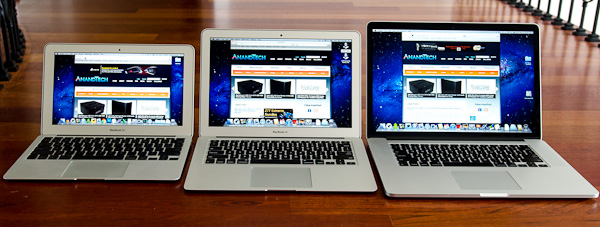
From left to right: 11-inch MacBook Air, 13-inch MacBook Air, MacBook Pro with Retina Display
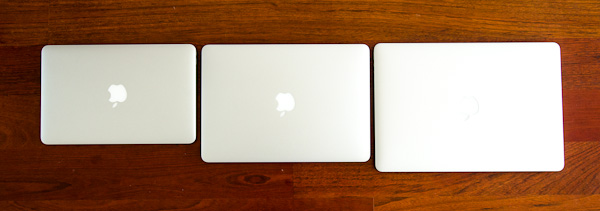
From left to right: 11-inch MacBook Air, 13-inch MacBook Air, MacBook Pro with Retina Display


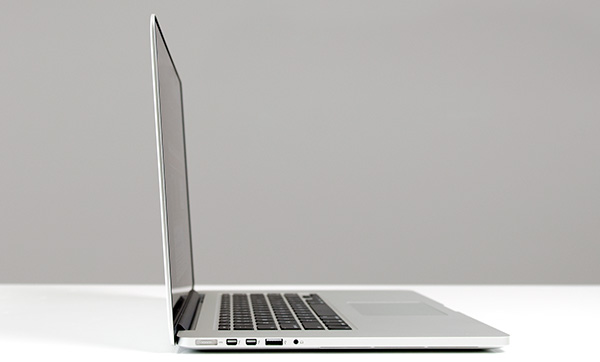
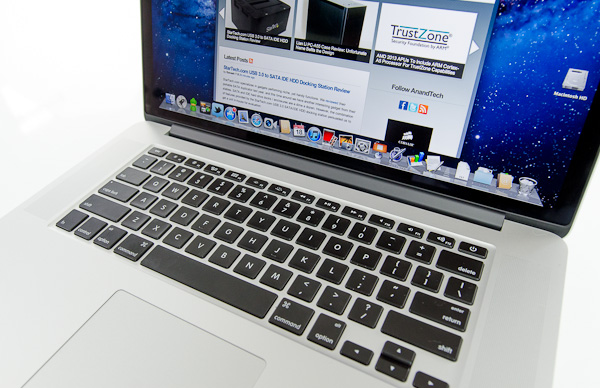
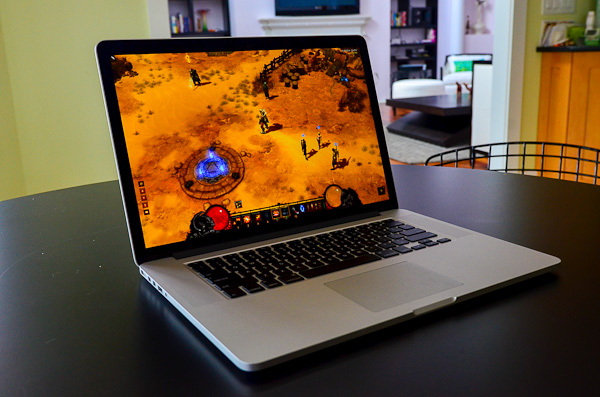
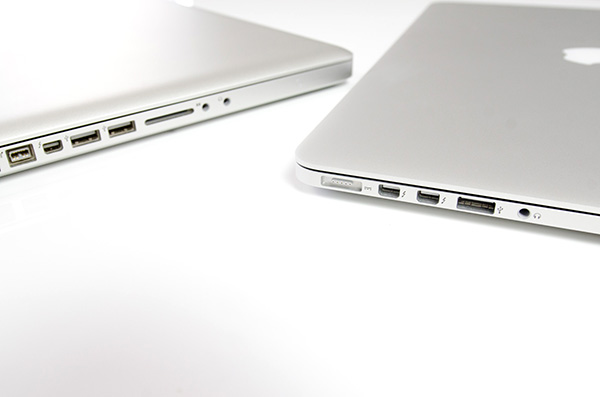
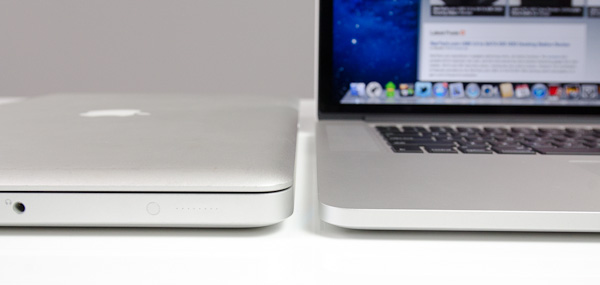








471 Comments
View All Comments
OCedHrt - Sunday, June 24, 2012 - link
He missed another important point. All of that was in 3 lbs. Now, the current generation starting from last summer has an external discrete graphics and optical drive connected via a thunderbolt based connector (because Apple had exclusivity) with the laptop being only 2.5 lbs.This isn't going to compare to the retina macbook pro though - at 15 inches 4.5 lbs is pretty impressive though I think if Sony wanted to do it they could do 4 lbs or less.
deathdemon89 - Saturday, June 23, 2012 - link
I agree completely, I'm a proud owner of the old Z, and even today it doesn't feel the least bit dated. And the 1080p screen is holding up admirably well, with no signs of pixellation at normal viewing distances. This device was truly innovative for its time. I still don't understand why it received such mixed reviews by the press.Spunjji - Monday, June 25, 2012 - link
Mainly the price. Only Apple are allowed to charge that much for a laptop. Also, only Apple can have hot systems. Repeat ad infinitum.mlambert890 - Wednesday, November 28, 2012 - link
Really ridiculous comment. I can see you are bitter, as is the other mega z fan, but come on already. I worked for Sony for 5 years and love the company. I have owned probably a dozen Vaios including the top of the line last gen Z (with the SSD RAID)Instead of ranting and raving you need to ask yourself *why it is* that "only Apple can charge so much" and why "Anand only gives a free pass to Apple"
You feel what exactly? That there is some grand conspiracy in play? Do you realize how ridiculous that sounds?
WHY has Sony *lost the ability to charge a premium*? In other words WHY have they *burned all customer loyalty and good will*? I left the company back in 1999 because I saw the writing on the wall.
You (and the other Z guy) are no different than any other apologist. Companies dont bleed marketshare and fail to sell cancer curing products (you guys are presenting the Z as "truly revolutionary" right?) for no reason. Sorry to tell you there is no "big conspiracy".
Sony sells super high priced products into a super commoditized market and then they layer on a CRAP TON of bloatware dragging the machine to a stop, make idiot decisions like the HDMI one, and push proprietary crap *worse* than Apple ever has. All of that into the Wintel space which, sorry to tell you, was *always* driven by the cheapest possible parts at the best possible price.
The PC industry grew *because it was cheap*. Apple *always* occupied a premium niche. I vividly remember the initial release of the Apple I, the Lisa, the Mac 128. These were all always premium products and the competition at the time (be it Commodore, Atari, Ti, or the wintel ecosystem) *always* captured share by being cheap.
That may annoy you for some reason, but Apple has pretty much *always* held a core premium audience. The only exception was the period of insanity when Jobs had been pushed out and Scully destroyed the company. Even then, the core fans stayed.
You two make it sound like poor Sony is a victim because the world doesnt all run out and by the Vaio Z.
Even *without Apple* Sony would be going under, hate to tell you. Sony's problems are Sony's and the whole is *not* the sum of its parts with a laptop.
solipsism - Saturday, June 23, 2012 - link
None of that makes sense and is, in fact, rubbish.Sony added 1080p because it was it was popular not because it made sense. You have a 168 PPI display on 13" machine which makes text too small to be a good experience for most users.
They also didn't use a good quality display or add anything to the SW to make the experience good (unlike what Anand talked about in this review), they just added the single metric that was trending because of HDTVs.
Blu-ray in a notebook has always been a silly option for most users. There is a reason the BRD adoption failed on PCs and it's not because everyone is stupid... except you. ODDs are long overdue for being removed since they take up 25% of the chassis, require them to placed at an edge reducing over 5" of port real estate and restricting design, require a lot of power, are noisy, more prone to break due to the many moving parts, are slow, are just too expensive to be feasible, and add nothing visually that most users trying to watch a movie can discern.
Quad-SSDs? Really? That's a sensible solution for a consumer notebook?
EnzoFX - Saturday, June 23, 2012 - link
and that really is what people don't get. It isn't just about raw specs. The package needs to be complete, polished, what have you. In this case of high dpi screens, is good scaling support, and Apple did it. Support on the software side is something they never get credit for by the Apple haters. All they can see is numbers and think "I've seen numbers like that before".mabellon - Saturday, June 23, 2012 - link
No Apple didn't do it. Just like on the iPad, they increased resolution by doubling width and height. Their software simply doesn't scale well to arbitrary higher resolution. If it was done right then Chrome would work out of the box - instead the OS 2x scales everything without increasing resolution/quality.To the consumer, the choice means a good experience without breaking apps. But claiming that Apple was successful simply bc of software? HA!
Ohhmaagawd - Saturday, June 23, 2012 - link
Did you actually read the retina part of the review?Chrome doesn't work right because they do their own text rendering. Read the review. If an app uses the native text rendering, the app will look good (at least the text portion). They will have to update the graphical assets of course.
BTW, Chrome Dev builds have this issue fixed.
Windows DPI setting isn't default, so few use or even know about the setting and devs haven't made sure they work properly in the high DPI settings.
Apple has made a move that will be short-term painful in having apps that aren't updated look a bit fuzzy. But since they made it default, this will force devs to update.
OCedHrt - Sunday, June 24, 2012 - link
What do you mean Windows DPI setting isn't default? You can change it in a few clicks, but the same thing applies - if your app does not read the DPI values, then Windows can't help you. This is because windows UI is not vector based (I don't know about now, but older apps definitely not) and many applications back then were coded with hard coded pixel counts.When the DPI is changed, windows scales the text but the UI dimensions is controlled by the application implementation.
KitsuneKnight - Saturday, July 7, 2012 - link
On Windows, changing the DPI will generally mean a huge amount of applications will become simply unusable.On this Retina MBP, the worst case appears to be slightly blurry text (which was quickly updated).
Apple's solution is a good one, because it does things in a way that should keep existing apps working fine, while allowing future developers to leverage new APIs to take advantage of the increased resolution.